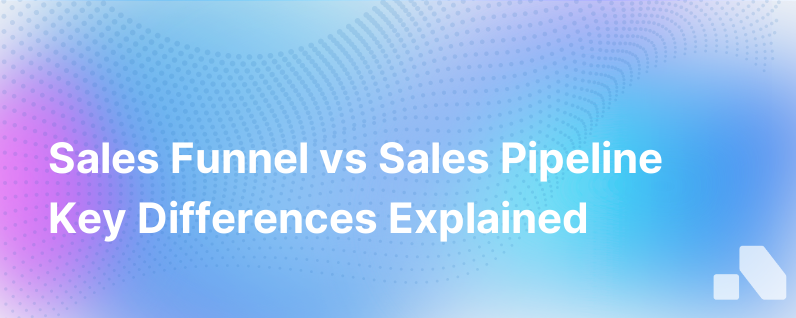Sales Funnel Vs. Sales Pipeline Whats The Difference
Published on August 18, 2023 by David Zhang
In the realm of sales and marketing, the terms "sales funnel" and "sales pipeline" are frequently bandied about, often interchangeably. However, this common practice belies the nuanced differences between the two concepts. Understanding the distinction is more than a matter of semantics; it's crucial for fine-tuning your sales strategy and forecasting future revenue.
At its core, the sales funnel illustrates the buyer's journey, representing the conversion process from a potential lead to an actual customer. On the other hand, the sales pipeline provides a snapshot of the sales process from the seller's perspective, tracking the status of various sales prospects in the stages leading up to a deal. These strategic tools allow sales teams to visualize and manage their sales processes, but they serve different purposes and impact businesses in unique ways.
Let's go into more depth to understand both concepts and how they differ from one another.
Sales Funnel: Understanding the Buyer’s Journey
The sales funnel, often depicted as an inverted pyramid, denotes the stages a customer goes through when making a purchase decision. As prospects pass through each stage of the funnel, their numbers decrease, simulating the narrowing shape of the funnel – hence the name.
Stages of the Sales Funnel
Awareness: At the top of the funnel, prospective customers become aware of your product or service.
Interest: Prospects who are aware of your offering start to show interest and engage with your content or sales team.
Desire: As interest develops into desire, prospects evaluate how well your product meets their needs.
Action: At the bottom of the funnel, the prospect takes action, such as making a purchase.
Some models add a post-purchase stage, Retention, emphasizing the importance of nurturing customer relationships after the sale to encourage repeat business and referrals.
The funnel helps businesses understand the customer mindset at each stage. By analyzing how potential customers behave and what decisions they make along the way, companies can identify bottlenecks or drop-off points and optimize their marketing and sales strategies accordingly.
This approach to understanding and leveraging the customer’s journey is instrumental in crafting targeted campaigns and content, ensuring that messaging and engagement tactics are appropriate for the stage in which the customer finds themselves.
Sales Pipeline: Tracking the Sales Prospecting Process
Whereas the sales funnel is customer-centric, the sales pipeline focuses on the sales process from the seller's perspective. It can be thought of as the backbone of sales operations, a systematic approach to guide sales professionals through the steps necessary to close a deal.
Stages of the Sales Pipeline
Prospecting: Finding potential customers and initiating contact.
Qualification: Determining whether a prospect is a good fit and has the potential to become a customer.
Proposal: Sending a detailed proposal or quote to the prospect.
Negotiation: Discussing terms and prices in hopes of coming to an agreement.
Closing: Successfully reaching an agreement and finalizing the sale.
Post-Sale: In some pipelines, this stage involves the delivery of the product or service and follow-up for customer satisfaction.
The pipeline provides a real-time view of where prospects are in the sales process. Sales teams review their pipelines regularly to prioritize activities, estimate how likely each deal is to close, and forecast sales for the coming period. Understanding the current state of the pipeline is crucial for resource allocation, performance assessment, and sales training.
Differences Between Sales Funnel and Sales Pipeline
Perspective: The funnel focuses on the customer’s view and their decision-making process, while the pipeline focuses on the seller’s actions and sales process.
Purpose: The funnel is about converting leads and nurturing relationships, emphasizing marketing tactics. The pipeline concentrates on tracking and increasing efficiency in the sales process.
Utility: The funnel is often used for strategic decision-making in marketing and product development, whereas the pipeline is a tactical tool that assists sales teams in their day-to-day operations and to hit sales targets.
Metrics: Key metrics for the funnel include conversion rates at each stage, whereas the pipeline focuses on metrics like the number of deals in each stage, average deal size, and pipeline velocity.
Dynamic Fluidity: The buyer's journey in the funnel is less predictable, with customers often looping back to previous stages, adding a non-linear complexity. Conversely, the pipeline is sequential; it follows a linear progression with well-defined steps.
Integrating Sales Funnel and Sales Pipeline
While the sales funnel and sales pipeline serve different purposes, they're interconnected. A comprehensive sales strategy integrates both to monitor the flow from potential customer to closed deal.
Aligning your sales funnel with your sales pipeline can help you ensure consistency and relevance throughout the buying process. Insights from the funnel's performance can inform adjustments in pipeline management, while data on pipeline performance can highlight areas for optimization in the funnel.
Leveraging Tools for Sales Funnel and Pipeline Management
Many companies now utilize advanced CRM platforms and sales engagement tools to manage their sales funnels and pipelines more effectively. These tools can automate tracking, provide analytics, and streamline communications, enabling sales professionals to focus on building relationships and closing deals.
To further amplify their sales processes, businesses are turning towards AI-powered solutions such as Aomni. Platforms like these gather real-time account research, competitive insights, and generate personalized sales content quickly and efficiently, empowering sales teams to be strategic and zero in on what they need to achieve their goals.
Conclusion
Understanding the distinction between the sales funnel and sales pipeline is a foundational element of building an efficient and effective sales strategy. While the funnel illustrates the customer's journey, the pipeline showcases the steps taken by sales teams to foster and finalize sales. Mastery over both concepts facilitates not just an understanding of customer behavior and sales operations but also drives more intelligent resource allocation and improved performance in sales. Integrating these models within modern sales platforms can provide businesses with a cutting-edge competitive advantage, driving sales growth and prosperity.